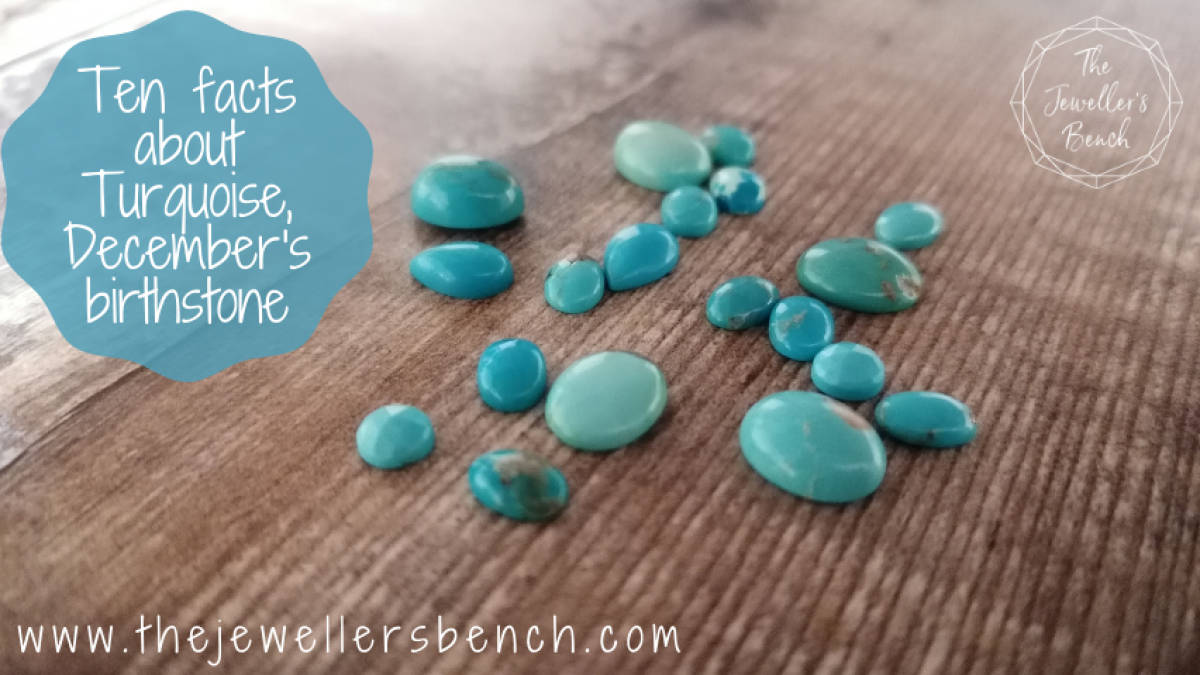Ten facts about Turquoise, December's birthstone

Beloved by numerous ancient cultures and just as popular today, Turquoise is one of December's birthstones.
Beloved by numerous ancient cultures and just as popular today, Turquoise is one of December's birthstones.
Read on to find out more about how it is formed, where it is mined and why is has always been so popular!

1. Turquoise is formed when water enters an iron-rich limonite or sandstone that contains copper, aluminum and other minerals, gathering those minerals together. It takes millions of years and the right conditions for turquoise to be formed. The presence of copper gives the blue, and the presence of aluminum adds a greenish hue to the stone.
2. Turquoise is known for its intense blue-green colour. The finest and rarest colour is an intense blue that is uniform throughout the stone such as the beautiful stones to the right, sourced from the Sleeping Beauty mines in Arizona, USA. You might assume that the name of the stone comes from it's colour, but it actually from the French word for Turkey since it was thought that the mineral originated there. The colour is named after the stone!
3. Turquoise is a relatively soft stone with a Mohs rating of between 5 and 6. Make sure that you handle it carefully, ideally storing it separately from other harder gemstones.
4. Turquoise isn't just one of December's birthstone, it's also important in Tibetan and Nepalese cultures. It is known as the 'Sky Stone' and has been revered by people in the Himalayas for thousands of years due to the belief that it came from the heavens. It is believed to bring protection and so children in Tibet are gifted turquoise gemstones to keep them safe on their journey through life.

5. Turquoise, especially that mined in the USA, often contains narrow vein-like markings of its host rock. These markings are known as the matrix. Limonite creates a dark brown marking while sandstone creates tan markings. The presence of a matrix can lower the value of a turquoise.
6. Turquoise was one of the earliest gemstones to be discovered and has been used in jewellery for thousands of years. As you can imagine this means that many cultures have special meanings for this beautiful stone. Medieval Europeans believed that turquoise helped you to achieve a higher state of consciousness, and, as mentioned above, to this day many Tibetans believe that the gemstone is as a talisman of good fortune.
7. Turquoise is sacred to many Native Americans. In the past, Native Americans would use it as a shaman’s stone, which were stones believed to have strong metaphysical properties for spiritual growth.

8. Ancient Persians wore turquoise around the neck or wrist to help protect themselves from unnatural death.
9. The most valuable turquoise gemstones can be found in Northeast Iran. Other notable deposits can be found in Afghanistan, Argentina, Australia, Brazil, China, Israel, Mexico, Tanzania, and the United States.
10. The Ancient Egyptians are well known for their love of turquoise, as shown by the amazing artifacts unearthed in tombs. Probably the most well-known piece is Tutankhamun’s iconic burial mask which was richly inlaid with the stone.
11. And a lastly bonus fact for you... watch out for cheap imitations when you buy turquoise. If the price seems too good to be true, it is! Turquoise is often dyed and stabilized with resins to produce a harder stone which retains its color and polish, and reconstituted turquoise is made from small chips and "chalk" to which dyes and plastic resin is added. There's nothing wrong with using these stones, as long as you and your customers are away of the difference. Other minerals such as chrysocolla have also been used to imitate turquoise.
Want to find out more about using gemstones in your jewellery?
Here are some useful blog posts and tutorials.
Categories: : birthstones, did you know, jewellery facts

Joanne Tinley
Tutor and Founder of The Jeweller's Bench
The Jeweller's Bench is run by Joanne Tinley. She has been making her own jewellery for as long as she can remember and left her first career as a school teacher to set up business as a jewellery designer and tutor nearly 20 years ago. She is
self-taught and like many people started with wire and beads. Learning how to solder, however, opened up a whole new world of jewellery making, one that she is keen to share!
 Joanne Tinley
Joanne Tinley 



